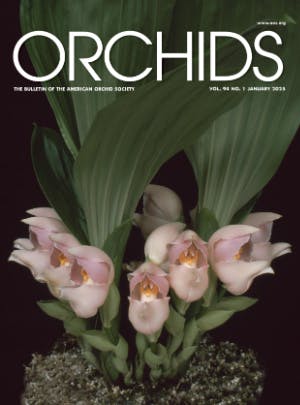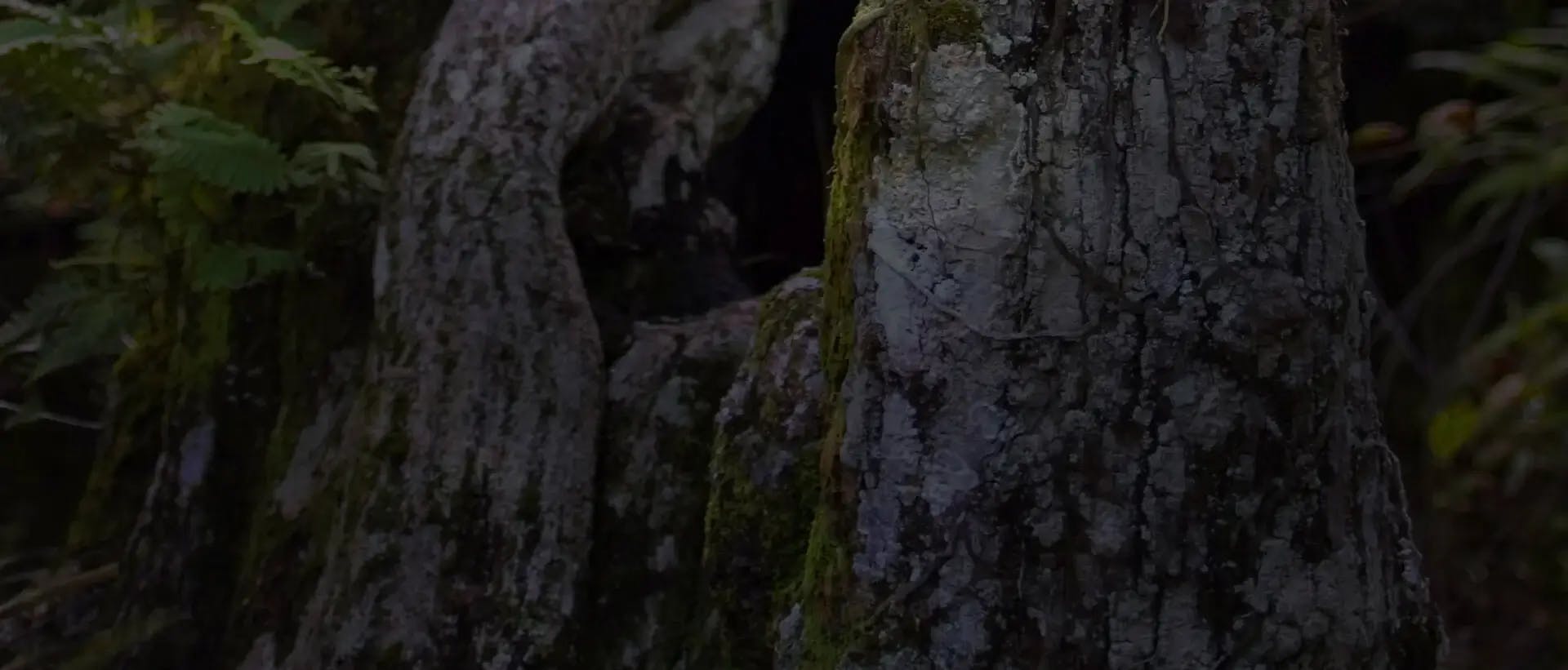
JANUARY
Orchid growing is as full of perversities as it is of fun, and the most experienced of us can kill plants as quickly as anyone else. There are, however, some general but basic reminders and suggestions to be followed. January is undoubtedly the quietest cultural month of the year, even if it is not the quietest month for weather. One can take a rest from potting and catch up on other necessary chores. For example, thoroughly clean up your plants, remove dead or diseased leaves, and follow this with a bath of dilute soap and water to remove dirt from the leaves. Make sure that the pseudobulbs are covered and remove loose and old sheaths. Inspect the bottom of the pots for slugs and snails. Plants having black spots caused by fungal diseases, that cannot be removed with a knife, can be treated with a bit of funcicide and then kept on the dry side for a while.
We presume that your growing space was thoroughly cleaned in the summer when plants could be placed outside. If not, then space must be made and the growing area itself cleaned. Plants can then be moved over to this clean space as they are treated.
Do not forget the glass if you are growing on a windowsill. The normal accumulation of grime can cut down needed light, so scrub and wash the glass as the space is cleared.
Ventilation this month depends on outside weather; give air whenever outdoor temperatures are high enough, if only for a short time. Your plants will appreciate the fresh air but avoid sudden changes and drafts.
This is the time of the year to be watchful of the temperature difference between your heated home and the windowsill or basement growing area. A difference of 10 or more degrees Fahrenheit (5.6 C) is not uncommon, and plants can freeze near a single-pane window or in an unheated basement or garage on sufficiently cold nights. A small fan facing away from the plants will help circulate air between the window and the general room. Speaking of freezing, watch out for bay windows. Many of these structures have uninsulated bottoms and while they make great growing areas concerning light availability, they can become dangerously cold on those cold winter nights.
Looking for species that flower this month?
Laelia albida is a rather small plant that produces five to eight 2 ½ -inch (6.4 cm) flowers with white sepals and petals and a rose-colored lip. The long-lasting flowers are beautiful in any collection.
[1] Laelia albida ‘Winston’ AM/AOS grown by Amy and Ken Jacobsen.

Lycaste deppei peaks in January. The long-lasting flowers are quite large with red-spotted green sepals, white petals and a yellow lip spotted red. These exotically colored flowers help brighten a dull January day.
[2] Lycaste deppei ‘Haley Suzanne’ HCC/ AOS grown by Glen Decker.

A little warmer spot in your growing area will accommodate Dendrobium wardianum and it will reward you with 3-inch (7.5 cm) white flowers whose sepals and petals are tipped amethyst. The lip has a bright yellow disc and contrasting red blotches at the base of the throat.
[3] Dendrobium wardianum grown by Cynthia Hill.

The three species above will thrive in intermediate conditions by adjusting the locations of the plants to suit individual likes and dislikes. The blooming season, of course, will vary a month or so depending on individual culture and greenhouse conditions.
FEBRUARY
Longer days and the resulting higher day temperatures will start many plants into activity but, February is a treacherous month and warm sunny days can quickly turn cold in many parts of the country, so beware. More water and ventilation will be required, but it is wise to water early on bright, sunny days. Before the rush of potting, finish the plant clean-up work, check all labels, and rewrite or replace them wherever necessary.
There are orchid species (and hybrids) that bloom every month of the year and a great many of them can be grown under intermediate conditions. Some February-blooming species include:
Cattleya lundii, a dwarf plant that produces 1½-inch (3.8 cm) lilac flowers with a beautiful, purple, frilled lip.
[4] Cattleya lundii ‘Santa Barbara’ HCC/AOS grown by the Santa Barbara Orchid Estate.

Rhynchostele rossii is a showy little plant that often flowers in February. The 3-inch (7.5 cm) flowers, produced two to five to an inflorescence, are white or rose-flushed, spotted with brown. The lip is white with a yellow crest.
[5] Rhynchostele rossii ‘Laramie’ AM/AOS grown by Bruce Embury.

Rhyncholaelia glauca is smaller in all respects than Rhyncholaelia digbyana, but the flowers are deliciously fragrant. The sepals and petals are white, tinted green and the lip is usually white and fringeless. Dendrobium fimbriatum has stems up to 4 feet (1.2 m) long and produces racemes up to 10 inches (25 cm) long carrying 3–15 flowers. The 3-inch (7.5 cm) blooms are deep orange-yellow and the lip has dense fimbriation.
[6] Dendrobium fimbriatum ‘Alfonso Q’ AM/ AOS grown by Alfonso Qu Rojas.

[7] Rhyncholaelia glauca

MARCH
The weather in March can still be treacherous in some parts of the country, while in others it is almost summer— or so it feels. But by March things are really popping, and this increased activity means more attention to culture, especially potting.
Besides spring orchid shows, attend your local orchid society meetings. It is interesting to listen to others’ ideas on potting materials, fertilizing methods, etc. Just remember, a wise person listens to all, sifts the information carefully, then goes home and evolves his own methods, slowly adopting new things and then trying these new things on a few plants for sufficient time before adopting them on a large scale.
The hardest part of orchid culture to understand is, without equal, watering. Great care must be exercised now. Plants making new growth need water, but resting plants can go for long periods without. While there are no specific rules, such as once a week, it is certainly better to err on the dry side. Winter, more than any other time, the adage “if in doubt, wait” could not be more appropriate. Keep seedlings growing, but beware of chilled water, as it can do damage. Watch out for excessively high humidity. Do not let resting plants shrivel.
With higher temperatures in March and more fresh air, it follows that more water must be used. At all times be judicious: strive to provide as much as growing plants can use, but remember that a single case of overwatering can mean dead roots. If in doubt, moisten the surface of the potting medium on bright days and wait another day or two before thoroughly watering. Check more frequently those plants on mounts. They, too, will need more frequent fertilizing as the days get longer and warmer.
By now, most genera should receive all the light they can get without burning so all window shading should be removed. Phalaenopsis and possibly paphiopedilums are the exceptions and may still benefit from light shade depending on the brightness of the growing space.
After the middle of February, it may be necessary to add some shade as the sun angle increases. What might have been ample light during winter’s short days may now be burning sun and once that ugly burn appears it is too late for that leaf.
By March the rule is to give as little shade as possible and increase as needed, judging from the condition of your plants.
Brassia verrucosa, Brassia aurantiaca, Cattleya cinnabarina and Dendrobium farmeri all flower in March. These plants will all grow in intermediate conditions if some experimentation is undertaken to find the most suitable location for each species.
Brassia verrucosa produces 6–15 striking flowers on a 2-foot (60 cm) inflorescence. The green-spotted black-purple sepals are 4 inches (10 cm) long, the petals about half as long, and the lip is white with black-green warts.
[8] Brassia verrucosa ‘Santa Barbara’ AM/ AOS grown by the Santa Barbara Orchid Estate.

Brassia aurantiaca has brilliant orange flowers on erect inflorescences. Although the flowers do not open fully, they make up for this with their brilliant color.
[9] Brassia aurantiaca ‘Monte Carmelo’ CCM/AOS grown by Gloria Norena.

Cattleya cinnabarina has 6–15 stellate 3-inch (7.5 cm) flowers of brilliant cinnabar.
[10] Cattleya cinnabarina ‘OrchidFix thanks Ben’ ccm/AOS grown by the OrchidFix Nursery.

Dendrobium farmeri displays its flowers in a pendent truss. The sepals and petals are white tinted pink or cream and the contrasting fringed lip is bright yellow. This species requires a cooler rest to flower well.
[11] Dendrobium farmeri ‘Boon Bryson’ HCC/AOS grown by Boon Bryson.

March is also the flowering season of the National Flower of Costa Rica — Guarianthe skinneri (commonly called Cattleya skinneri) — and there are many fine forms available in shades of purple, lavender, what are called “blue” tones in cattleyas and even white. Everyone should have one of these in their collections. The plants are easy to grow under intermediate conditions and put on a spectacular spring display.
[12] Guarianthe skinneri ‘Ovidio Pacheco’ AM/AOS grown by Eduardo Pacheco.

CULTURE
During the winter months, most orchids grown in the home will need little or no fertilizer. As days lengthen and light levels increase in March, light feeding can be increased but follow directions carefully. As with pesticides, if a little is good, more is NOT better.
Except for seedlings making active growth which should be potted as needed, most mature plants should be left alone during the darker, shorter winter days. By February, paphiopedilums and cymbidiums can be potted just as soon as they are finished flowering. Water sparingly until live roots are active. A light dampening of the potting mix surface will help to encourage new root growth. Do not be too anxious to divide plants. Orchids flower best when they are mature, well-established, generally multigrowth plants.
March begins the potting season in earnest so tackle the job early; catch cymbidiums as flowers fade but only if the pots are crowded or the potting medium is in poor shape. Cattleyas, just as the roots are breaking, not after they are 2 inches (5 cm) long, are ripe for potting. Divide or save the backbulbs. Plants of the Oncidium Alliance are ready when the new growths are 3–4 inches (7.5-10 cm) tall and new root growth is beginning. Use as small a pot as possible, especially if you have a heavy hand with water. Check the plants on mounts; they may need more fiber or another wire. Plants in fir bark should be given a thorough soak, then allowed to remain on the dry side (this does not mean kept like the Sahara Desert — just slightly drier) until roots penetrate the potting mix.
Keep a lookout for insect and mite infestations. There is nothing worse than a thriving colony of scale or mealybugs during the winter months when you cannot take plants outside to treat them. Mealybugs seem to be the bane of everyone’s existence but a touch of alcohol with a soft brush will handle small infestations and buy time to get plants outside later in the spring. Do not forget that a stroll through the growing area at night with a flashlight will reveal many an unsuspected marauder.
An invasion of aphids often appears from nowhere by March. It is not that they dropped out of the sky. They were there all winter as microscopic eggs which hatched with the onset of warmer conditions. It is sometimes difficult to spray when they are on flower spikes and hand removal may be necessary.












